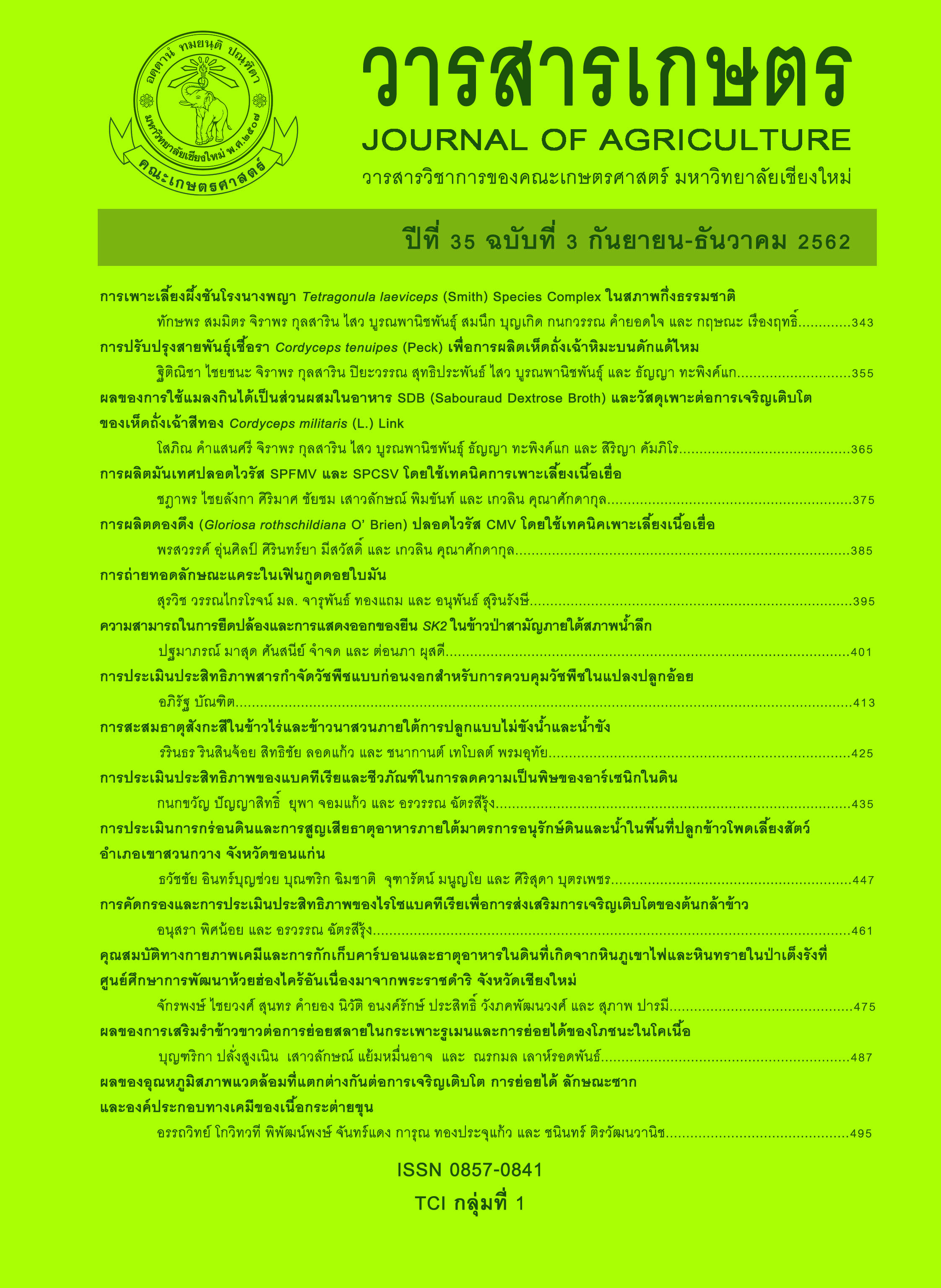การคัดกรองและการประเมินประสิทธิภาพของไรโซแบคทีเรียเพื่อการส่งเสริมการเจริญเติบโตของต้นกล้าข้าว
Main Article Content
บทคัดย่อ
ข้าว (Oryza sativa L.) เป็นพืชเศรษฐกิจที่สำคัญพืชหนึ่งของประเทศไทยและการใช้ปุ๋ยเคมีในการปลูกข้าวก็ได้มีการปฏิบัติกันอย่างแพร่หลาย ซึ่งทำให้ก่อให้เกิดปัญหาหลายประการ เช่น การปนเปื้อนมลพิษในแหล่งน้ำ การเสื่อมโทรมของดิน และการสูญเสียความหลากหลายทางชีวภาพ ส่งผลให้มีความเสี่ยงต่อสุขภาพของมนุษย์ การใช้แบคทีเรียที่เป็นประโยชน์ในการปลูกข้าวจึงเป็นทางเลือกหนึ่งในการลดปัญหาดังกล่าว ดังนั้นในการทดลองนี้จึงได้ทำการแยกแบคทีเรียจากดินรอบรากข้าว จากพื้นที่ปลูกข้าวแบบเกษตรอินทรีย์จำนวน 4 พื้นที่ในจังหวัดเชียงใหม่ ได้แก่ อำเภอแม่วาง 2 พื้นที่ อำเภอแม่แตง 1 พื้นที่ และอำเภอพร้าว 1 พื้นที่ ได้ไรโซแบคทีเรียจำนวน 56 ไอโซเลท ทำการคัดกรองเชื้อที่มีความสามารถตรึงไนโตรเจนและย่อยละลายฟอสเฟตเบื้องต้นเชิงคุณภาพบนอาหารแข็ง โดยคัดเลือกไอโซเลทที่มีความสามารถสูงได้ 13 ไอโซเลท ผลของการคัดกรองเชิงปริมาณในอาหารเหลวพบว่า ไอโซเลท RMW4NF1 มีความสามารถในการตรึงไนโตรเจนสูงที่สุด รองลงมาคือ RMT2NF4 (887.4 และ 822.9 นาโนโมล C2H4/หลอด/24 ชั่วโมง ตามลำดับ) และ RMW4NF1 สามารถละลายฟอสเฟตได้สูงสุดถึง 181.46 มิลลิกรัม P/ลิตร เมื่อทำการประเมินการผลิต indole-3-acetic acid (IAA) พบว่า RMW3NF4 สามารถผลิต IAA ได้สูงที่สุดรองลงมาคือ RMT2NF4 (34.93 และ 31.05 มิลลิกรัม IAA/ลิตร ตามลำดับ) จากศักยภาพในการส่งเสริมการเจริญเติบโตของพืชทั้งหมดที่ได้ประเมินจึงได้คัดเลือกไอโซเลทได้จำนวน 6 ไอโซเลท คือ RMW2Egg2, RMW2Egg8, RMW4Egg5, RMW4NF1, RMT2Egg2 และ RMT2NF4 มาทดสอบประสิทธิภาพต่อการเจริญเติบโตและการดูดใช้ธาตุอาหารของต้นกล้าข้าว พบว่า การใช้ไรโซแบคทีเรียส่งเสริมการเจริญของต้นกล้าข้าวและการดูดใช้ธาตุอาหารเกือบทุกไอโซเลทให้ค่าสูงกว่ากรรมวิธีควบคุมอย่างมีนัยสำคัญทางสถิติ โดยที่ไอโซเลท RMT2NF4 ให้ค่าการดูดใช้ไนโตรเจนและฟอสฟอรัสสูงกว่ากรรมวิธีควบคุม 214 และ 74 เปอร์เซ็นต์ ตามลำดับ ดังนั้นไอโซเลทนี้จึงมีศักยภาพสูงในการนำมาพัฒนาเป็นปุ๋ยชีวภาพสำหรับข้าว
Article Details
References
Boutté, Y., Y. Ikada and M. Grebe. 2007. Mechanisms of auxin-dependent cell and tissue polarity. Current Opinion in Plant Biology 10(6): 616-623.
EI-Komy, H.M.A. 2005. Co-immobilization of Azospirillum lipoferum and Bacillus megaterium for successful phosphorus and nitrogen nutrition of wheat plants. Food Technology Biotechnology 43(1): 19-27.
Gaur, A.C. 1990. Physiological functions of phosphate solubilizing micro-organisms. pp. 16-72. In: A.C. Gaur (ed.). Phosphate Solubilizing Micro-organisms as Biofertilizers. Omega Scientific Publishers, New Delhi.
Gordon, S.A. and R.P. Weber. 1951. Colorimetric estimation of indole acetic acid. Plant Physiology 26(1): 192-195.
Gravel, V., H. Antoun and R.J. Tweddell. 2007. Growth stimulation and fruit yield improvement of greenhouse tomato plants by inoculation with Pseudomonas putida or Trichoderma atroviride: Possible role of indole acetic acid (IAA). Soil Biology and Biochemistry 39(8): 1968-1977.
In-nok, A., P. Poomipan and O. Thepsilvisut. 2016. Comparison on quality of rice var. Khao Dawk Mali 105 planted by using chemical and organic fertilizers in Surin province. Thai Science and Technology Journal 24(5): 766-776. (in Thai)
Insalud, N., P. Sangruan and K. Leechaikul. 2015. The influence of IAA producing bacteria on the stimulation of growth in rice. Agricultural Science Journal 46(3): 625-628. (in Thai)
Jatupornpipat, M., A. Rittiboon and C. Nopparat. 2011. Evaluation of nitrogen fixing efficiency of bacteria isolated from soils by acetylene reduction assay. pp. 1-6. In: Proceedings of the 21st Thai Institute of Chemical Engineering and Applied Chemistry. Prince of Songkla University, Songkhla. (in Thai)
Keyeo, F., O. Noor Ai’shah and H.G. Amir. 2011. The effects of nitrogen fixation activity and phytohormone production of diazotroph in promoting growth of rice seedlings. Biotechnology 10(3): 267-273.
Koomnok, C., N. Teaumroong, B. Rerkasem and S. Lumyong. 2007. Diazotroph endophytic bacteria in cultivated and wild rice in Thailand. ScienceAsia 33: 429-435.
Kravchenko, L.V., T.S. Azarova, N.M. Makarova and I.A. Tikhonovich. 2004. The effect of tryptophan present in plant root exudates on the phytostimulating activity of rhizobacteria. Microbiology 73(2): 156-158.
Mala, T. 2007. Organic Fertilizer and Biofertilizer: Production Techniques and Application. 2nd ed. Kasetsart University Press, Bangkok. 300 p. (in Thai)
Malav, K.J. and V.P. Ramani. 2016. Yield and nutrient content of rice as influenced by silicon and nitrogen application. Research Journal of Chemical and Environmental Sciences 4(4): 46-49.
Marschner, P., C.H. Yang, R. Lieberei and D.E. Crowley. 2001. Soil and plant specific effects on bacterial community composition in the rhizosphere. Soil Biology and Biochemistry 33(11): 1437-1445.
Maruekarajtinplaeng, S. 2014. Diversity of nitrogen fixing bacteria isolated from rice rhizosphere soil in Phranakhon Si Ayutthaya province. VRU Research and Development Journal Science and Technology 9(3): 72-83. (in Thai)
Patel, P.V. and P.B. Desai. 2015. Isolation of rhizobacteria from paddy field and their traits for plant growth promotion. Research Journal of Recent Sciences 4: 34-41.
Punyadoung, C. 2007. Production of soybean-rhizobium inoculum by spray-drying. M.S. Thesis. Chiang Mai University, Chiang Mai. 98 p. (in Thai)
Sarin, S., T. Prombunchachai, N. Nakaew and A. Chidburee. 2013. Isolation of indole acetic acid producing pink pigmented facultative methylotrophs (PPFMs) from Murdannia Ioriformis (Hassk.) R. Rao & Kammathy. Naresuan University Journal 21(2): 12-24. (in Thai)
Siwasilp, N. 1984. Handbook of Soil, Plant and Fertilizer Analysis. Department of Soil Science and Conservation, Faculty of Agriculture, Chiang Mai University, Chiang Mai. 138 p. (in Thai)
Somasegaran, P. and H.J. Hoben. 1994. Handbook for Rhizobia: Methods in Legume-Rhizobium Technology. Springer-Verlag, New York. 397 p.
Surange, S., A.G. Wollum II, N. Kumar and C.S. Nautiyal. 1997. Characterization of rhizobium from root nodules of leguminous tree growing in alkaline soils. Canadian Journal of Microbiology 43(9): 891-894.
Tanimoto, E. 2005. Regulation of root growth by plant hormones- role for auxin and gibberellins. Critical Reviews in Plant Sciences 24(4): 249-265.
Wanchai, K. and S. Ruangsangka. 2014. Effect of phosphate-solubilizing bacteria immobilized on rice husk ash, on growth of RD47 rice. Agricultural Science Journal 45(2)(Suppl.): 513-516. (in Thai)
Wattanaphayapkul, W. 2015. Effects of wood vinegar and manure on growth, yield and seed quality of Hom Mali rice. Journal of Agriculture 31(3): 269-279. (in Thai)
Weaver, R.W. and S.K.A. Danso. 1994. Dinitrogen fixation. pp. 1019 -1046. In: R.W. Weaver, J.S. Angle, P.S. Bottomley, D. Bezdicek, S. Smith, A. Tabatabai and A. Wollom. (eds.). Methods of Soil Analysis. Part 2: Microbiological and Biochemical Properties. Soil Science Society of America, Inc., Madison, Wisconsin.
Wilson, P.W. and S.G. Knight. 1952. Experiments in Bacterial Physiology. Burgess, Minneapolis. Minnesota, 49 p.
Yasari, E., A.M.E. Azadgoleh, H. Pirdashti and S. Mozafari. 2008. Azotobacter and Azospirillum inoculants as biofertilizers in canola (Brassica napus L.) cultivation. Asian Journal of Plant Sciences 7(5): 490-494.
Yesuf, E. and A. Balcha. 2014. Effect of nitrogen application on grain yield and nitrogen efficiency of rice (Oryza sativa L.). Asian Journal of Crop Science 6(3): 273-280.
Yiam-on, T., N. Riddech, P. Jaisil and S. Boonlue. 2012. Growth promotion of sugarcane by phosphate solubilizing bacteria in green house condition. Khon Kaen Agricultural Journal 40(Suppl. 3): 185-193. (in Thai)

